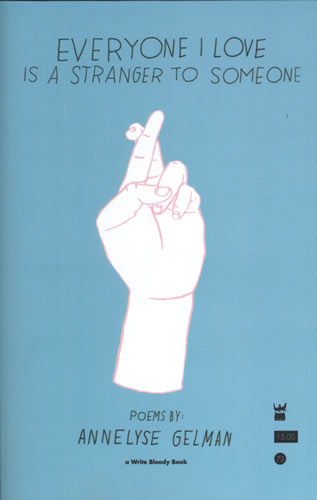Everyone I Love is a Stranger to Someone
The poetry in Everyone I Love is a Stranger to Someone by Annelyse Gelman is witty, comfortable, and contemporary. Nothing too heavy waits inside the bright blue cover, and even the heavier moments are lightened by Gelman’s sly humor, a welcome presence throughout the poems. The poetry in Everyone I Love is a Stranger to Someone by Annelyse Gelman is witty, comfortable, and contemporary. Nothing too heavy waits inside the bright blue cover, and even the heavier moments are lightened by Gelman’s sly humor, a welcome presence throughout the poems.
“Hypothetical No. 1” and “Hypothetical No. 2” trace through hypothetical situations, the first beginning, “What if eyes were like teeth / so that around puberty your baby eyes would loosen and fall out” and continues wondering about the change. “Hypothetical No. 2” is an equally enjoyable read, only fifteen syllables long.
Love poems are also repeatedly sprinkled throughout the collection, more than one simply titled “Love Poem” which appear in short bursts. “The Pillowcase,” one of the other included love poems, showcases what I liked about Gelman’s voice:
[. . .] I don’t remember what you said
when the condom broke. Probably ‘Oh, shit.’
The next day we drove into town. I took a pill
and another pill and it was over. I couldn’t tellthe difference, could have told my friends
but didn’t, just made lots of dead baby jokes
and went to bed in your dorm room.
While maybe not the most perfect love story that comes to mind, there’s something contemporarily familiar about the world in which it takes place: reading Haruki Murakami out loud together, shopping at GoodWill for a fish-printed pillowcase, smoking weed, and telling fairytales. There’s a blunt honesty here that continues on through all the poems in Everyone I Love is a Stranger to Someone and quickly became one of my favorite aspects of the book.
The collection caters more toward the millennial generation, especially seen in poems like “Selfie,” in which Gelman explains what millennial means to her:
[. . .] ‘millennial’ means
the box of Cheerios my father bought
in the year 2000 and keeps in his garage, deluded
into thinking it might someday be worthsomething.
and in “<3” with its title and a shout out to dubstep.
The last section of the book is the poem “An Illustrated Guide to the Post-Apocalypse,” made up of six parts and accompanied by sketches of a dead bee which rolls around the pages like a halting, short-lived flipbook. Despite the helpless image of the bee and the end of the world, the poem ends on a lighter note:
You can’t touch the world
without being touched back,
not even after the world ends.
[. . .]
so applause my hands, you—you accident of flesh—
We are not victims of life!
We are survivors of death.
The book ends in a spiraling black scribble, an ending that found me unwilling to put the book down.
This is Gelman’s first book of poetry, but if anyone else is left wanting more, her website provides videos of some of the poems in this collection, including an animation for “Giraffe,” a humorous ode to the animals that “already look like you are / dying”; and “Ars Poetica,” in which Gelman auditions for the role of herself.
Gelman has created a universe that beckons readers in with mastered dark humor, honesty, and intelligence. I’ll be eagerly awaiting more.





